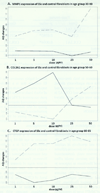IMPACT OF AGE AND AUTOANTIBODY STATUS ON THE GENE EXPRESSION OF SCLERODERMA FIBROBLASTS IN RESPONSE TO SILICA STIMULATION
- PMID: 25435887
- PMCID: PMC4244759
- DOI: 10.1177/1721727x1301100307
IMPACT OF AGE AND AUTOANTIBODY STATUS ON THE GENE EXPRESSION OF SCLERODERMA FIBROBLASTS IN RESPONSE TO SILICA STIMULATION
Abstract
Environmental factors are believed to play an important role in the pathogenesis of systemic sclerosis (SSc). Silica exposure has been implicated as potentially hazardous in epidemiological studies of SSc. It can activate fibroblasts to express profibrotic genes at certain conditions. The aim of this study is to examine whether the fibroblasts of SSc patients respond to silica particles with specific gene expressions differentially from normal control fibroblasts. The fibroblasts obtained from skin biopsies of 96 SSc patients and 104 controls were examined. Silica particles were used to perturb the cultures of the fibroblasts in time-course and dose-response assays. The transcript levels of COL1A2, COL3A1, MIVIP1, MMP3, TIMP3 and CTGF genes of the fibroblasts were measured with quantitative RT-PCR. The results showed that the expressions of all six genes in SSc fibroblasts under silica perturbation appeared significantly different from normal control fibroblasts. In age stratified analysis, compared to control fibroblasts, SSc fibroblasts from patients at age 30-40 years and 50-60 years displayed significantly decreased expressions of MMP1 gene in all dosage assays and increased expression of COL3A1 genes started at low dosages perturbation of silica particles, respectively. In autoantibody stratified analysis, specific gene expression patterns were significantly associated with autoantibody-subgroups of fibroblasts. A common feature of SSc fibroblasts was unstable and a wide range of gene expression changes in response to silica perturbation. Our studies may suggest an altered intrinsic dynamic control in SSc fibroblasts. In addition, sensitivity and specificity of SSc fibroblasts to potentially hazardous environmental trigger is age and autoantibody-subgroup-dependent. The fibroblasts of SSc patients at age 30-60 years may be more sensitive to silica perturbation toward a profibrotic gene expression.
Keywords: autoantibody; fibroblasts; gene expression; scleroderma; silica.
Conflict of interest statement
Figures


Similar articles
-
Attenuation of collagen production with small interfering RNA of SPARC in cultured fibroblasts from the skin of patients with scleroderma.Arthritis Rheum. 2006 Aug;54(8):2626-31. doi: 10.1002/art.21973. Arthritis Rheum. 2006. PMID: 16871529
-
Effects of the immunosuppressant rapamycin on the expression of human α2(I) collagen and matrix metalloproteinase 1 genes in scleroderma dermal fibroblasts.J Dermatol Sci. 2014 Jun;74(3):251-9. doi: 10.1016/j.jdermsci.2014.02.002. Epub 2014 Feb 17. J Dermatol Sci. 2014. PMID: 24630239
-
Systemic sclerosis (scleroderma): specific autoantigen genes are selectively overexpressed in scleroderma fibroblasts.J Immunol. 2001 Dec 15;167(12):7126-33. doi: 10.4049/jimmunol.167.12.7126. J Immunol. 2001. PMID: 11739535
-
Autoantibody response against a novel testicular antigen protein highly expressed in testis (PHET) in SSc patients.Autoimmun Rev. 2007 Mar;6(4):228-31. doi: 10.1016/j.autrev.2006.08.006. Epub 2006 Sep 1. Autoimmun Rev. 2007. PMID: 17317613 Review.
-
Systemic sclerosis.J Dermatol. 2018 Feb;45(2):128-138. doi: 10.1111/1346-8138.14153. Epub 2017 Dec 10. J Dermatol. 2018. PMID: 29226387 Review.
Cited by
-
Fibroproliferative genes are preferentially expressed in central centrifugal cicatricial alopecia.J Am Acad Dermatol. 2018 Nov;79(5):904-912.e1. doi: 10.1016/j.jaad.2018.05.1257. Epub 2018 Jun 18. J Am Acad Dermatol. 2018. PMID: 29913259 Free PMC article.
References
-
- Diot E, Giraudeau B, Diot P, Degenne D, Ritz L, Guilmot JL, Lemarie E. Is anti-topoisomerase I a serum marker of pulmonary involvement in systemic sclerosis? Chest. 1999;116:715–720. - PubMed
-
- Jarzabek-Chorzelska M, Blaszczyk M, Jablonska S, Chorzelski T, Kumar V, Beutner EH. Scl 70 antibody--a specific marker of systemic sclerosis. Br J Dermatol. 1986;115:393–401. - PubMed
Grants and funding
LinkOut - more resources
Full Text Sources
Other Literature Sources
Miscellaneous
